Conservation Articles
Contents
- What’s the Word on Watersheds?
- Which Watershed Do You Call Home?
- Water Pollution Hits Home
- Putting Pollution in Perspective
- Happy Cows, Happy Creeks: Agriculture and Our Watersheds.
What’s the Word on Watersheds?
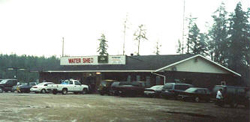 By Lisa Flinn, Crawford County Conservation District Intern
By Lisa Flinn, Crawford County Conservation District Intern
“Watershed” has recently been an environmental buzzword used in newspapers and on TV. But what is the big deal with a watershed? What is it, even? Can people affect it? Is this something we should be concerned about? Well, the “big deal” with a watershed is that we all live in one and our actions, whether they are responsible or not, can affect the health of our watershed.
Which Watershed Do You Call Home?
By Lisa Flinn, Crawford County Conservation District Intern
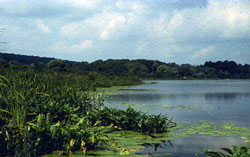 The map shown here depicts the different watersheds in Crawford County Crawford County Watershed Map. You can actually find your “Watershed Address.” Instead of thinking, “I live at 916 Martin Street (for example), which is in Meadville, which is in Pennsylvania, which is on the Eastern half of the U.S., etc.,” one could think, “I live by Cussewago Creek, which flows into French Creek, which meets the Allegheny River to flow into the Mississippi, etc.” By thinking in terms of watershed boundaries instead of municipal boundaries, we can begin to have an appreciation of the environment we live in and how we can do the least harm to it.
The map shown here depicts the different watersheds in Crawford County Crawford County Watershed Map. You can actually find your “Watershed Address.” Instead of thinking, “I live at 916 Martin Street (for example), which is in Meadville, which is in Pennsylvania, which is on the Eastern half of the U.S., etc.,” one could think, “I live by Cussewago Creek, which flows into French Creek, which meets the Allegheny River to flow into the Mississippi, etc.” By thinking in terms of watershed boundaries instead of municipal boundaries, we can begin to have an appreciation of the environment we live in and how we can do the least harm to it.
Water Pollution Hits Home
By Lisa Flinn, Crawford County Conservation District Intern
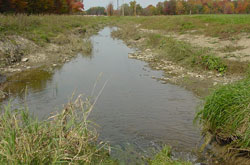 Water pollution is often linked to large industries with foul pipes secretly spewing waste into our waters. People normally don’t think of themselves as part of the pollution problem, but we are all responsible for polluted waters since sources of pollution come from our own homes and yards. From chemical drain “uncloggers” to chemical lawn feeders, we regularly use potent pollutants in and around our homes. Does this have an effect on the environment? Of course it does.
Water pollution is often linked to large industries with foul pipes secretly spewing waste into our waters. People normally don’t think of themselves as part of the pollution problem, but we are all responsible for polluted waters since sources of pollution come from our own homes and yards. From chemical drain “uncloggers” to chemical lawn feeders, we regularly use potent pollutants in and around our homes. Does this have an effect on the environment? Of course it does.
Putting Pollution in Perspective
By Lisa Flinn, Crawford County Conservation District Intern
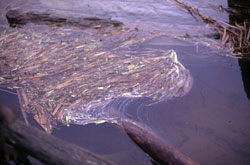 Which is worse: chemical discharge from a pipe or pesticides from 50 suburban lawns running off into a creek? Actually, they rank at about the same level since they all can be potentially poisonous. But which would the public consider worse socially? Certainly, it is easiest to point a finger at a large industry discharging waste into a creek, but that is only because industrial discharge is a point source of pollution. Point source means that the pollution can be traced back to one source; it is identifiable.
Which is worse: chemical discharge from a pipe or pesticides from 50 suburban lawns running off into a creek? Actually, they rank at about the same level since they all can be potentially poisonous. But which would the public consider worse socially? Certainly, it is easiest to point a finger at a large industry discharging waste into a creek, but that is only because industrial discharge is a point source of pollution. Point source means that the pollution can be traced back to one source; it is identifiable.
Happy Cows, Happy Creeks: Agriculture and Our Watersheds
By Lisa Flinn, Crawford County Conservation District Intern
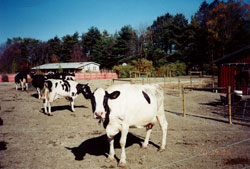 From stream-bank fencing to barn-yard stabilization to milk-house collection systems, farmers have come a long way in promoting healthy watersheds through the use of Best Management Practices (BMPs). Local farmers speak out about the need for water quality and the responsibility everyone shares in maintaining water standards. Frank Field, a dairy farmer in Springboro says, “If the American people want clean water, they have to do their part too. That way it’s a win-win situation, but if it’s all on the farmers’ shoulders, it’s uneconomical for us.” According to National Land Cover Data (NLCD), agricultural lands account for 37.4% of land use in Crawford County, making proper farming practices crucial.
From stream-bank fencing to barn-yard stabilization to milk-house collection systems, farmers have come a long way in promoting healthy watersheds through the use of Best Management Practices (BMPs). Local farmers speak out about the need for water quality and the responsibility everyone shares in maintaining water standards. Frank Field, a dairy farmer in Springboro says, “If the American people want clean water, they have to do their part too. That way it’s a win-win situation, but if it’s all on the farmers’ shoulders, it’s uneconomical for us.” According to National Land Cover Data (NLCD), agricultural lands account for 37.4% of land use in Crawford County, making proper farming practices crucial.

